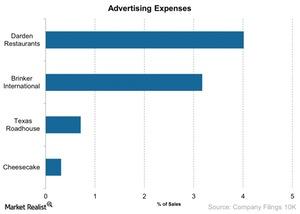Understanding Texas Roadhouse’s Marketing Approach
A company can increase its marketing and promotional activities to bring in more customers and obtain operating leverage.
Jan. 1 2015, Updated 1:09 p.m. ET

Advertising and marketing
In the last part of this series, we learned that Texas Roadhouse (TXRH) was affected by food inflation over the past two years. A company can increase its marketing and promotional activities to bring in more customers and obtain operating leverage. Restaurant companies, which have fixed costs such as rents, achieve operating leverage when they can spread costs over a higher number of customers. This helps reduce the company’s overall costs.
In 2013, TXRH spent about 1% of its revenues on advertising. Darden Restaurants (DRI), which operates LongHorn Steakhouse, spent 4% of its sales on advertising. Brinker International (EAT), which operates Chili’s, spent 3%, and The Cheesecake Factory (CAKE) spent 0.3% of its sales on advertising and marketing expenses.
You may consider the Consumer Discretionary Select Sector SPDR Fund (XLY) to invest in some of the restaurants we’ve mentioned above.
Selecting appropriate media
McDonald’s (MCD), which has restaurant units all across the US, can benefit from a national advertising campaign. But restaurants with a smaller footprint, such as Texas Roadhouse, may not benefit from such an extensive campaign. The company relies on local, regional, and national public relations to promote its brand. Public relations are as good as free advertising. For example, a mention on a list of steakhouses released by a third party can get customers to visit a restaurant.
TXRH also uses “permission-based e-mail loyalty programs,” which usually entail sending offers and promotions to registered customers.
These advertising campaigns also benefit franchise restaurants, and the company collects advertising fees from its franchises.
